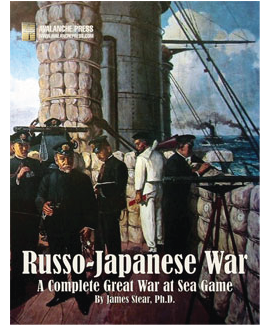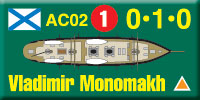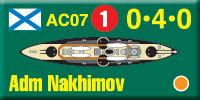| Russo-Japanese War:
Russian Armored Cruisers, Part One
By Mike Bennighof, Ph.D.
February 2022
 For decades before the Russo-Japanese War, the Imperial Russian Navy saw commerce raiding as an important mission, perhaps its most important mission. Planners identified Britain as the most likely future enemy, with tensions running high over rivalries in Central Asia and the Ottoman Empire, and no one believed that Russia could match British sea power. To threaten British commerce, Russia developed a new type of ship, the armored cruiser. For decades before the Russo-Japanese War, the Imperial Russian Navy saw commerce raiding as an important mission, perhaps its most important mission. Planners identified Britain as the most likely future enemy, with tensions running high over rivalries in Central Asia and the Ottoman Empire, and no one believed that Russia could match British sea power. To threaten British commerce, Russia developed a new type of ship, the armored cruiser.
General-Admiral, the first such ship, caused an international stir when she appeared in 1875. She and her sister were modernized in 1892 and 1896, but retained in the Baltic as training ships during the Russo-Japanese War and later converted into minelayers.
The Russians ordered a new and much more modern pair of armored cruisers in 1880, but so many design changes were made to both ships during the course of construction that they emerged from the shipyards as very different vessels.
 Both Vladimir Monomakh and Dmitri Donskoi were designed as central-battery ironclads, but classed as armored cruisers since they had an armored belt. They had an armored “citadel” amidships, where they carried most of their six-inch guns (12 for Vladimir Monomakh, 14 for Dmitri Donskoi) , but their largest weapons (four 8-inch guns for Vladimir Monomakh, two of them for Dmitri Donskoi) were in armored sponsons. Vladimir Monomakh had her sponsons in the “corner” positions; Dmitri Donskoi’s were amidships on either side. Both Vladimir Monomakh and Dmitri Donskoi were designed as central-battery ironclads, but classed as armored cruisers since they had an armored belt. They had an armored “citadel” amidships, where they carried most of their six-inch guns (12 for Vladimir Monomakh, 14 for Dmitri Donskoi) , but their largest weapons (four 8-inch guns for Vladimir Monomakh, two of them for Dmitri Donskoi) were in armored sponsons. Vladimir Monomakh had her sponsons in the “corner” positions; Dmitri Donskoi’s were amidships on either side.
The two ships displaced about 6,000 tons, about the same size as contemporary French cruisers, but considerably smaller than British ships of similar type and function. They did have newly-developed compound armor, and were some of the first ships built with this new and much more effective type of protection (made of fused steel and iron plates, but more resistant to the newly-developed armor-piercing shells than either metal separately) rather than the wrought-iron plates used previously. While their armor was up-to-date, their internal subdivision was poor. They did have good range, and were built as fully-rigged sailing ships to help extend their time at sea for their commerce-raiding mission.
 They saw extensive services on the far seas, representing Russian interests in the Mediterranean and the Far East. Both were rebuilt in the late 1890’s, trading in their now-obsolete 8- and 6-inch guns for a smaller number of modern weapons: five 6-inch and six 4.7-inch guns for Vladimir Monomakh, and six 6-inch and ten 4.7-inch guns for Dmitri Donskoi. Their long-distance deployments resumed, and when the Russo-Japanese War began Dmitri Donskoi was in the Mediterranean with orders to deploy to the Pacific Squadron, while Vladimir Monomakh had returned home for a refit. They saw extensive services on the far seas, representing Russian interests in the Mediterranean and the Far East. Both were rebuilt in the late 1890’s, trading in their now-obsolete 8- and 6-inch guns for a smaller number of modern weapons: five 6-inch and six 4.7-inch guns for Vladimir Monomakh, and six 6-inch and ten 4.7-inch guns for Dmitri Donskoi. Their long-distance deployments resumed, and when the Russo-Japanese War began Dmitri Donskoi was in the Mediterranean with orders to deploy to the Pacific Squadron, while Vladimir Monomakh had returned home for a refit.
Both ships joined the fateful voyage to Tsushima. They were both assigned to protect the fleet’s transports and so missed the early part of the battle, but were hunted down afterwards and scuttled by their own crews after heavy damage from torpedo and gunfire hits.
 Not satisfied with either Vladimir Monomakh or Dmitri Donskoi, the Russians either stole the plans for the British armored cruiser Imperieuse or purchased them from a third party. They laid down Admiral Nakhimov in 1881 as a more-or-less direct copy of the British ship. Either the Russians did not obtain a full set of the British plans or they altered them, and Admiral Nakhimov had much poorer underwater protection than did the British ship. She also carried a different main armament, with eight 8-inch and ten 6-inch guns. Not satisfied with either Vladimir Monomakh or Dmitri Donskoi, the Russians either stole the plans for the British armored cruiser Imperieuse or purchased them from a third party. They laid down Admiral Nakhimov in 1881 as a more-or-less direct copy of the British ship. Either the Russians did not obtain a full set of the British plans or they altered them, and Admiral Nakhimov had much poorer underwater protection than did the British ship. She also carried a different main armament, with eight 8-inch and ten 6-inch guns.
Like the earlier armored cruisers, Admiral Nakhimov spent her first two decades showing St. Andrew’s banner around the world, including a stint as the first flagship of the Russian Pacific Squadron. In 1903 she returned home for modernization, including replacement of her ancient main battery with modern quick-firing guns. The work was not complete when the Russo-Japanese War began, nor had new guns been installed when Admiral Nakhimov was assigned to the Second Pacific Squadron for the voyage to Tsushima.
Placed in the battle-line due to her impressive firepower (on paper, anyway: her obsolete, slow-firing guns had no place in modern naval warfare and she's probably overrated in the game), she took heavy damage from the Japanese armored cruisers and was hit by a torpedo during the night pursuit. She sank the next day off the island of Tsushima, apparently scuttled by her own crew.
 Pamiat Azova, laid down in 1886, was an enlarged version of Dmitri Donskoi, with an emphasis placed on long-range commerce raiding. She had a pair of 8-inch guns in sponsons with only armored shields to protect them, and thirteen 6-inch guns in completely unprotected mounts. She was a terribly-designed fighting ship, but did provide the desired long range and served well as Tsesarevitch Nicholas’ private yacht during his fateful 1891-1892 cruise to Asia. Pamiat Azova, laid down in 1886, was an enlarged version of Dmitri Donskoi, with an emphasis placed on long-range commerce raiding. She had a pair of 8-inch guns in sponsons with only armored shields to protect them, and thirteen 6-inch guns in completely unprotected mounts. She was a terribly-designed fighting ship, but did provide the desired long range and served well as Tsesarevitch Nicholas’ private yacht during his fateful 1891-1892 cruise to Asia.
For the rest of the century, Pamiat Azova performed the usual power projection mission in the Mediterranean and Far East, returning to St. Petersburg in 1901 for massive reconstruction. Work proceeded slowly, as naval architects attempted to remedy her poor design, and when the Russo-Japanese War erupted she had received new Belleville boilers and had had her outdated, slow-firing guns removed, but the new weapons had not yet been mounted. Work on her fell behind as the refitting of ships for the Second and Third Pacific Squadrons took priority, and she did not receive her new outfit of 6-inch guns until the last days of 1904.
Captain Nikolai Klado, a Russian naval officer, filled newspapers with opinion columns demanding that every ship that could float be sent to fight the Japanese. “All of these old ships,” he wrote, “could be used to attract the enemy’s fire and consequently diminish the number of projectiles which might otherwise strike the modern ships which we have already sent on.”
Klado’s views took hold and Pamiat Azova was assigned to the newly-formed Fourth Pacific Squadron along with the newly-completed battleship Slava and the ancient training battleship Alexander II. Fortunately for their crews, the war ended before they could be sent to attract the enemy’s fire. Klado would be imprisoned as an indirect result of his idiotic writings, and later use that experience to cast himself as a victim of Tsarist oppression and wrangle command of the Bolshevik naval academy after the October Revolution.

Vladimir Monomakh (forefront) and Dmitri Donskoi (behind her).
Immediately after the war Pamiat Azova’s crew mutinied in support of Russian revolutionaries. They killed their captain and four officers, and steamed around the Gulf of Finland trying to convince the garrisons of coastal fortresses to rise along with them. Receiving no support, they surrendered the ship after non-revolutionary factions of the crew rose against them in a counter-mutiny, and 17 sailors plus one university student who’d snuck aboard to preach the revolution were later executed. Pamiat Azova later became a depot ship and was torpedoed and sunk by the British in 1919.
The first Russian attempts at a long-range cruiser produced ships very capable of showing the flag in peacetime and representing Russian interests around the globe, but very poor fighting ships. With their next series of armored cruisers, the Russian Navy would try to remedy that by roughly doubling the size of the ships.
You can order Russo-Japanese War right here.
Sign up for our newsletter right here. Your info will never be sold or transferred; we'll just use it to update you on new games and new offers.
Mike Bennighof is president of Avalanche Press and holds a doctorate in history from Emory University. A Fulbright Scholar and NASA Journalist in Space finalist, he has published a great many books, games and articles on historical subjects; people are saying that some of them are actually good.
He lives in Birmingham, Alabama with his wife, three children, and his Iron Dog, Leopold.
Want to keep Daily Content free of third-party ads? You can send us some love (and cash) through this link right here.
|
